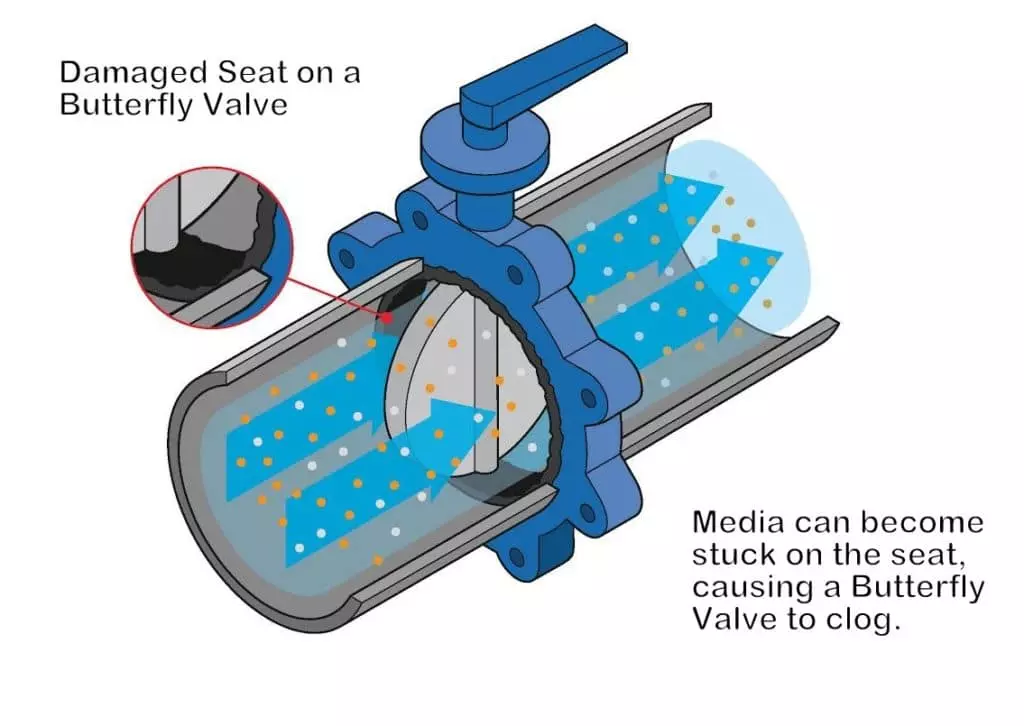1) The butterfly valve seat has poor processing quality; the procedure was not sufficiently thorough, leading to pores, cracks, and uneven hardness on the sealing ring.
2) Incorrect selection or manipulation of the butterfly valve is the cause. The butterfly valve will not comply to the working conditions and the valve seat sealing ring will be damaged as a result of incorrectly choosing the butterfly valve type in accordance with the real working environment.
3) The valve seat may be damaged as a result of careless maintenance or haphazard butterfly valve installation. Impurities in the pipeline cause harm to the butterfly valve's seat before the butterfly valve is fitted because the pipeline and the inside of the valve body are not cleansed. Secondly, neglecting to repair the butterfly valve on time results in the valve remaining unhealthy and prematurely deteriorating the seat sealing ring.
4) The chemical deterioration of the butterfly valve seat medium: in the absence of current generation, the medium surrounding the butterfly valve seat sealing ring interacts chemically with the butterfly valve seat and corrodes it.
5)The erosion of the valve seat occurs continuously in the medium of the pipeline containing suspended particles, some of which are corrosive. The butterfly valve seat sealing ring is situated inside the pipeline. Such a medium will erode the valve seat and cause damage to the sealing surface.
6) Damage to the butterfly valve's seat caused by mechanical means. The butterfly plate will grind against the butterfly valve's seat with each opening and closing, causing more and more wear and tear to the sealing surface.
7) The butterfly valve seat electrochemical corrosion, the contact between the sealing surfaces, the contact between the sealing ring and the valve body and the closing body, the difference in medium concentration, the difference in oxygen concentration, etc., will all result in a potential difference and electrochemical corrosion, which will cause the valve seat sealing ring on the anode side to corrode.
8) Fatigue damage to the butterfly valve seat: butterfly valve seats have a limited service life, especially the soft sealing butterfly valve seat, which ages quickly with prolonged use and develops cracks and delamination on the sealing surface, which impairs sealing performance.
 In many industrial applications, it is essential to prevent damage to the butterfly valve seat in order to operate efficiently. The following remedies and precautions can help you minimize or prevent damage to the butterfly valve seat:
In many industrial applications, it is essential to prevent damage to the butterfly valve seat in order to operate efficiently. The following remedies and precautions can help you minimize or prevent damage to the butterfly valve seat:1)Proper installation:Make sure you install the valve appropriately, adhering to the instructions provided by the manufacturer. An improper installation may cause the valve seat to be overstressed and misaligned.
2)Frequent maintenance: Establish a regular timetable for checking and servicing the valve. This entails examining the parts for wear and tear, making sure they are adequately lubricated, and quickly resolving any problems.
3)Select the appropriate material: Opt for valve materials that are impervious to the particular media being worked with. Think about employing specialist materials that can survive exposure to caustic or abrasive agents.
4)Limit flow velocity: Steer clear of high flow rates as they may erode and harm the valve seat. Make that the valve is the right size to meet the necessary pressure and flow rates.
5)Use the right gaskets and seals: Make sure the gaskets and seals are of a high caliber and appropriate for the intended use. If necessary, replace them to stop leaks that could cause harm to the seat.
6)Temperature control: Make sure the system is kept at the right temperature. Severe heat waves have the potential to erode the material of the valve seat, causing it to break or deteriorate.
7)Keep the valve operating within its limitations: Recognize the maximum pressure and temperature limits of the valve and keep it operating within these ranges. Overdoing these bounds can shorten the valve's lifespan and harm the seat.
8)Control water hammer and cavitation: Use pressure-reducing devices and appropriate system design to address problems with water hammer and cavitation. These occurrences have the potential to seriously harm valve seats.
9)Check for wear on a regular basis: Look for wear indicators like erosion, pitting, or scoring on the valve seat. Major problems can be avoided by detecting minor ones early on.
10)Put maintenance protocols into action: Create and put into action maintenance protocols that outline how often to do inspections and when to replace important parts, such valve seats. Retain precise documentation of all maintenance operations.
11)Invest in high-quality valves: Get butterfly valves of the highest caliber from reliable suppliers. High-quality valves are less prone to early wear and damage.
12)Provide training to operators: Ascertain that individuals in charge of controlling the valves have received instruction in correct operation, upkeep, and diagnosis. Operational mistakes that could result in seat damage can be avoided by knowledgeable operators.
13)Consider employing soft-seated butterfly valves in applications that require tight shut-off. Strong materials used in these valves maximize sealing and minimize seat wear.
You may drastically lower the chance of seat damage and increase the lifespan of these vital parts in your industrial processes by implementing these preventative steps and routinely checking the condition of your butterfly valves.
